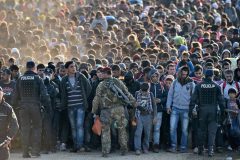
Migrants being escorted by Slovenian Police in 2016 (Source: Getty Images)
Although the European Union has a good record in human rights, there are still some areas of concern for the EU. As the EU expands, it must learn how to deal with asylum and migration. Particularly alarming to EU leaders is the rise of racism and xenophobia in relation to the increase in numbers of foreigners seeking entry to the EU. If the EU is to be a true upholder of human rights principles, it must take steps to ensure that human rights are offered to all its inhabitants, citizen or non-citizen. This involves a deep assessment of the EU’s immigration and asylum policies
Immigration is a concern for EU countries because:
- many countries in the EU have, for a long time, been used to having people migrate FROM their countries, not TO their countries
- although the population in the EU is getting older, and there are fewer younger workers to replace the older workers who will soon retire, it is unclear that immigrants to Europe will help solve the problem of an ageing work force
- it is unclear how well the member states’ welfare systems can support immigrants who are not economically self-sufficient.
In response to these concerns, the EU’s approach has been to limit the number of immigrants entering the EU. As a result, the number of asylum applications has increased because for many people in third countries, claiming asylum is becoming the only possible way to enter Europe. CLICK HERE to see statistics about asylum seekers entering the European Union.
For many EU countries, asylum is a sensitive issue because:
- they have only begun to be considered as popular destinations for asylum seekers in recent years
- the countries’ resources are limited, and there is a perception that an influx of asylum seekers and refugees will stretch these resources; therefore,
- there is also a perception that the EU’s human rights obligations to provide a place of asylum for refugees conflicts with its desire for economic integration and advancement.

Pearson International Airport in Toronto
Overall, both immigration and asylum pose problems for EU officials because:
- with the introduction of the Schengen policy and the right of free movement, internal borders no longer exist. This means that the EU’s external borders are vital in keeping the security of the EU. Allowing mass numbers of asylum seekers, and to some extent, immigrants, may erode that sense of security
- the visibility of many of these immigrants and asylum seekers have heightened the sense of xenophobia in Europe. We see this in the rise of right-wing, anti-immigration political parties.
| Key Terms | |
| What is a refugee?
According to Article 1 of the Geneva Convention, a refugee: “is a person outside his or her country of nationality or habitual residence; has a well founded fear of persecution because of his or her race, religion, nationality, membership in a particular social group or political opinion; and is unable or unwilling to avail himself or herself of the protection of that country, or to return there for fear of persecution.” However, among the member states of the European Union, there is a wide range of how this definition is interpreted. What problems does this pose in establishing a common asylum and refugee policy for the EU |
What is asylum?
Asylum is: “a form of protection given by a State on its territory based on the principle of non-refoulement and internationally or nationally recognized refugee rights. It is granted to a person who is unable to seek protection in his/her country of citizenship and/or residence in particular for fear of being persecuted for reasons of race, religion, nationality, membership of a particular social group or political opinion.” (Source: Eurostat) |
How should the EU deal with these issues?
Have a discussion with your classmates on the following possible solutions. What are the pros and cons for each of the solutions, from the perspective of the European Union countries, and from the perspective of the asylum seekers and migrants? (We have provided some links to help you with this discussion.)
Click here for more information.
| Possible Solution 1:
Close off immigration to Europe even further. Have stricter requirements for people wishing to immigrate to any EU country. Have tougher standards for granting asylum to asylum seekers.
|
| Possible Solution 2:
Have EU member states contribute more money to the EU, so that this money can be redistributed to those states that receive the highest number of immigrants and asylum seekers. These funds will be used toward helping countries integrate their foreigners into society.
|
| Possible Solution 3:
Instead of focusing on keeping people OUT of Europe, the EU member states should do more to help integrate people who are already IN Europe (i.e., those whose asylum applications are successful). If migrants to Europe are seen as being a useful part of society, local populations might be more open to receiving more immigrants, refugees and asylum seekers. |
| Possible Solution 4:
Along with focusing on protection from persecution, the EU should focus on prevention of persecution in third countries. For example, give financial aid to aid organizations that deal with situation of unrest in third countries. The EU is already taking an active role in this area. CLICK HERE | FR for more information. |
![]() NEWS LINKS
NEWS LINKS![]()
“Immigration quotas will not protect our continent” from the Slovak Spectator
“Migration to Europe is slowing, but the political issue is as toxic as ever” from the New York Times
“Austria’s refugees increasingly rejected by society” from EU Business
“EU summit ‘to close the windows’ to immigrants” from EurActiv
![]() Web Resources
Web Resources![]()
The 1951 Geneva Convention on Refugees | FR
United Nations High Commissioner for Refugees | FR
European Council on Refugees and Exiles | FR
U.S. Committee for Refugees
Here’s a link back to the Human Rights main page.